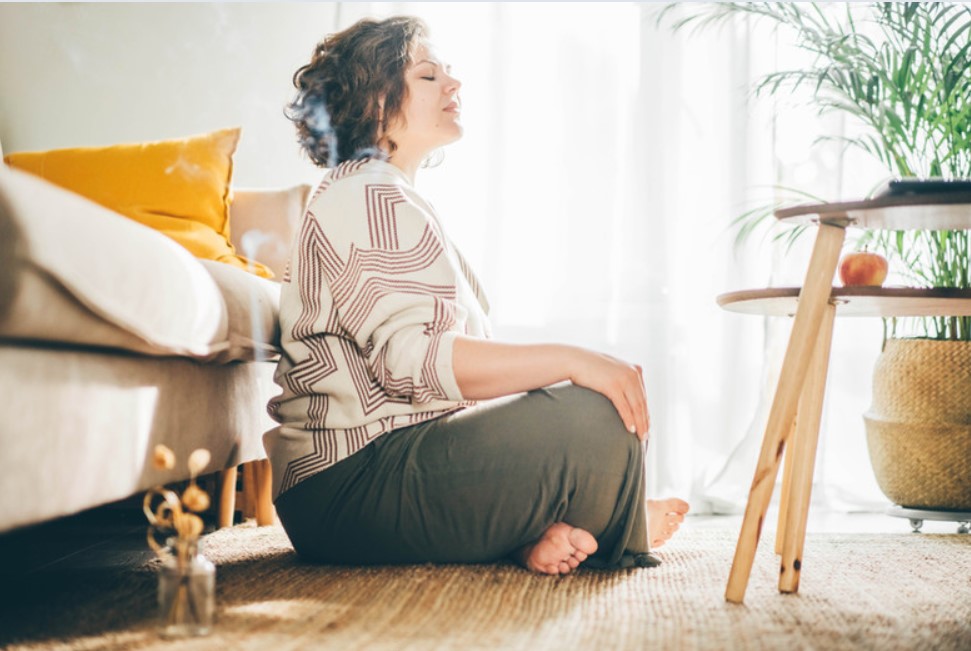By Christine Saari, MA, E-RYT, C-IAYT
Hold it right there, breathers. You know that 4-7-8 breathing technique you’ve been using to cope with anxiety? Yeah, the one that’s making rounds on every self-help blog and mindfulness app? It might be making your symptoms worse.
“But wait!” I hear you say, “I’ve been using the 4-7-8 breathing technique religiously!”
Trust me, I feel your surprise. But let’s dig a little deeper.
4-7-8 Breath: The Breathing Bummer
In the 4-7-8 breath, the 4 and the 7 represent inhalation and retention of air respectively. Sounds good so far, right? Well, here’s the catch: both inhalation and retention of breath are associated with our body’s sympathetic nervous system response. In layman’s terms, these actions are like hitting the gas pedal in our nervous system. They ramp up anxiety symptoms and increase the speed and intensity of our thoughts. Not quite what we’re aiming for, right?
So, the well-intended 4-7-8 breath might help slow our rate of respiration, meaning fewer breaths per minute – which is a thumbs up. But at the same time, it’s like stepping on the gas, causing your nervous system to speed up when you’re trying to slow down. Not the best choice when our goal is anxiety reduction, is it?
A Fresh Breath of Air
Now, I don’t mean to leave you hanging there, thinking that all is lost. Because it’s not. We can tweak this a bit and make it work for us. Meet your new best friend: the 4-0-6-2 breath.
Here’s how it goes: 4 is your inhale, 0 means there’s no retention of breath, 6 is your exhale, and 2 is the suspension of breath (breath held out).
Why is this better? Well, by lengthening the exhale and adding in that little pause at the end, we emphasize the actions that stimulate the parasympathetic nervous system response. This is your body’s natural “brake” – it helps slow things down, reduces the frequency and intensity of thoughts, and creates a feeling of safety.
And who doesn’t want to feel safe and calm when anxiety is running rampant?
Breathwork, Yoga Philosophy, and You
You might be wondering why the 4-0-6-2 breath works. To understand that, let’s take a detour into the world of yoga philosophy and its insights on pranayama, the control of breath.
Breathwork Basics in Yoga and Ayurveda – The Dance of Brahmana and Langhana
In the Ayurvedic tradition, pranayama is divided into two energetic principles: Brahmana and Langhana. Brahmana refers to inhalation and translates to expansion. On the flip side, Langhana refers to exhalation and means reduction.
Brahmana practices invigorate and energize the body and mind, promote vitality, boost energy, and support the metabolism. Sounds quite a lot like our sympathetic nervous system, doesn’t it?
On the other hand, Langhana practices aim to relax and calm the body and mind. They slow the heart rate, lower blood pressure, and shift the nervous system into a parasympathetic state. It’s like applying the brakes, bringing about a sense of calmness and tranquility.
Breaking Down the Breath: It’s All About Ratio!
So, here’s where it gets really interesting. Remember how we talked about Brahmana and Langhana? Let’s look at how they play out in real life – or rather, real breath.
Imagine you’re baking a cake. You know how the ratio of ingredients can make the difference between a heavenly dessert and a kitchen disaster? The same idea applies to our breathwork. The ‘recipe’ for our breath, or the ratio of Brahmana (inhalation and retention) to Langhana (exhalation and suspension), can seriously influence how we feel.
Take our friend, the 4-0-6-2 breath. By shifting the ‘ingredients’, placing more emphasis on the Langhana component, we’re turning up the relaxation factor. It’s like creating the perfect dessert for anxiety reduction – deliciously calming and just right.
The Science Behind Langhana Breathwork
Analyzing the ratio of the Brahmana (inhalation and retention) and Langhana (exhalation and suspension) components in our breathing technique helps us understand their energetic effects.
The 4-0-6-2 breath, with its emphasis on Langhana, maximizes the relaxation benefits for anxiety reduction.
This principle is supported by modern research, too. A 2023 study by Balban et al. discovered that cyclic sighing, which mirrors the Langhana aspect of breathwork, is highly effective for mood regulation. Their findings suggest that “intentional control over breath with specific breathing patterns produces more benefit to mood than passive attention to one’s breath, as in mindfulness meditation practice.1“
So, just as the ancient wisdom of yoga suggests, emphasizing the Langhana aspect of our breath, as validated by the Balban et al. study, offers a tangible and effective strategy for managing anxiety and promoting a more positive mood.
It’s an affirmation that the old and the new, the traditional and the scientific, can come together to guide us towards better mental health.
Leaving 4-7-8 Breath Behind: Onwards to Calmness
So, yes, while the 4-7-8 breath might be the talk of the town, it’s not necessarily the best choice for those looking to maximize the benefits of breathwork for anxiety reduction. It’s better than not doing breathwork, but if you’re looking to take your anxiety management to the next level, why settle for better when you can have the best?
So, next time you feel that familiar wave of anxiety rolling in, remember: 4-0-6-2. Inhale for four, skip the retention, exhale for six, pause for two. A little shift, but it might just make a world of difference.
Take a deep breath – the right kind of deep breath – and sail towards calmness. Because you deserve to feel at peace. And this, my friend, might be one of the secrets to getting you there.
Learn Breathwork With a Yoga Therapist
Attempting to adjust our breathing practices on our own can sometimes feel like navigating a maze. You might question if you’re controlling your breath correctly, feel unsure whether to breathe through your mouth or nose, experience tension when trying to breathe deeply, or even feel an overwhelming sense of being unable to breathe when attempting to regulate your breath.
Does any of that ring a bell?
If so, remember, there’s absolutely no shame in seeking some guidance – that’s where yoga therapists step in. These professionals are trained to personalize your breathwork journey, helping you to comfortably and effectively master techniques like the 4-0-6-2 breath.
But how do you find a yoga therapist? It’s easier than you might think. Many organizations, like Yoga Therapy Associates or the International Association of Yoga Therapists, can help connect you with certified yoga therapists near you.
You’re not alone in this journey, and there are resources available to support you every step of the way. Remember, it’s never too late to take control of your health, and finding the right breathing technique for your anxiety is a giant stride in the right direction.
So why wait?
Find your yoga therapist and start reaping the benefits of individualized breathwork today.
References:
Balban, M. Y., Neri, E., Kogon, M. M., Weed, L., Nouriani, B., Jo, B., Holl, G., Zeitzer, J. M., Spiegel, D., & Huberman, A. D. (2023). Brief structured respiration practices enhance mood and reduce physiological arousal. Cell Reports Medicine, 4(1), 100895. https://doi.org/10.1016/j.xcrm.2022.100895




